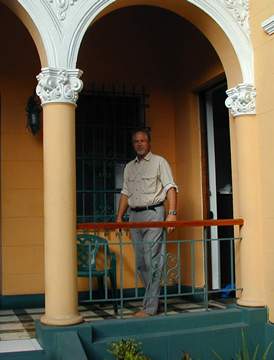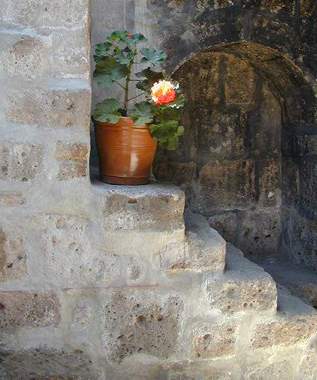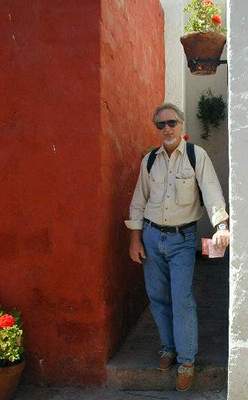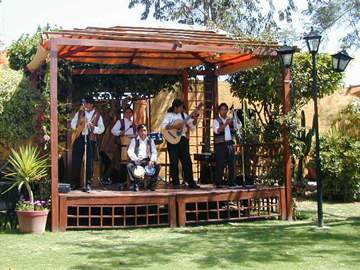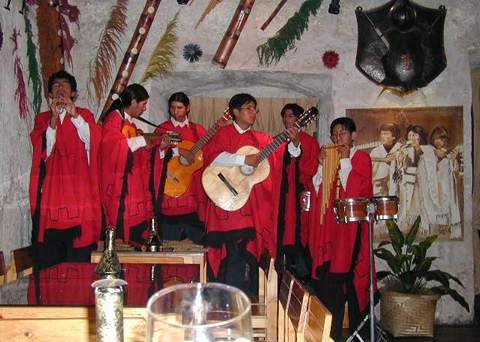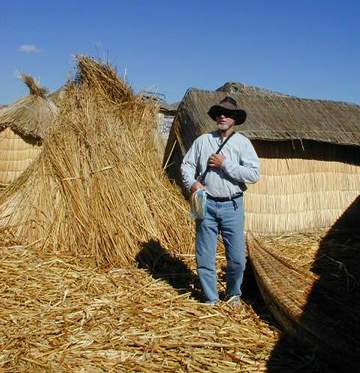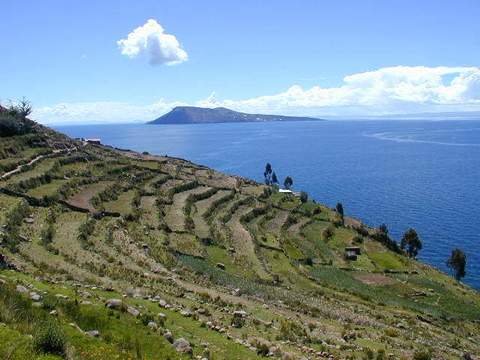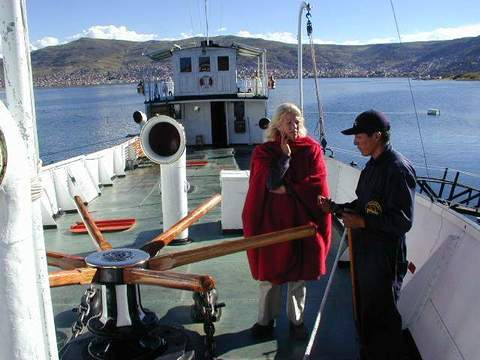Adventures aboard SV/Thaleia
| In Peru: Lima, Arequipa, Puno and Lake Titicaca |
|
Our posada in Lima was lovely, in a quiet neighborhood, and very affordable. |
In Lima, we visited the Museo del Arte (no pictures here) and very much enjoyed the pre-Columbian and Inca artifacts, the model of the Nazca lines, and the art. We also enjoyed the ceviche corvina in Lima at Heidi in the downtown area and in Miraflores at Albertos. Peru has the best ceviche I've ever eaten, and it's served with large crunchy kernels of corn called cancha. Wonderful! |
|
Arequipa at 2325 meters above sea level is set in the western Andes in the high desert. The bus ride to Arequipa from Lima revealed a stark landscape that is perhaps the driest place on earth, some places never recording a drop of rainfall. The people of Arequipa are primarily indigenous and very friendly. The town houses a monastery (among many other historical sites), lots of shops for finding alpaca items for the family, and plenty of good music and food. | |
|
The stonework adorned with flowers adds charm and warmth that is missing from the more austere living quarters of the nuns. |
The Monasterio de Santa Catalina is not a monastery at all--it's a convent. Built in 1580 with the money of the rich widow Guzman, the convent accepted only women from the best families. In those times, the second daughter of upper class families was expected to join a convent and to renounce all material goods. The nuns in this convent, however, had slaves, hired musicians and chefs; hardly a life of poverty. In 1871 the Pope sent a nun to the convent to straighten things out. She freed the servants and the slaves and sent the dowries back to Europe. From that time until just recently, few people other than the cloistered nuns have seen the convent. The high walls that surround the convent enclose an entire village--20,000 square meters. It is arranged in clusters of rooms surrounding common areas where meals were taken, prayers were given, and charity work was done. The monastery has been partially restored--pastel colors, artful stonework, religious art and brightly colored flowers all make this site a wonderful place to exercise your digital camera settings. |
|
These wonderful colors are seen throughout the convent. |
|
| On a different note, the musicians at the Sol De Mayo restaurant entertained the patrons in the courtyard.
|
John had cuy (roasted guinea pig), a traditional Arequipeño dish. I had the rocoto relleno, a stuffed, flavorful, slightly picante, pepper--a cousin of the bell pepper. mmmmmmmm!!!
|
|
This group entertained us in another lovely restaurant in Arequipa. The colors alone were magnificent enough, but their music was authentic Andean--zampoñas (pan pipes) of many sizes, flautas (flutes), charangos--a ten string instrument slightly smaller than a guitar, guitars, and tinyas--drums. In contrast, the posters in the restaurant were authentic rock and roll (see the Beatles poster in the background?) | |
 |
We were in Arequipa for Good Friday, a day when the ceremony takes to the street. Below, the faithful are celebrating the Via Crucis (the way of the cross). The men carried the cross out of the cathedral and around the square, stopping at various points to pray and to commemorate the events of the crucifixion. Left is a beautiful girl who was with her family helping to sell the prayer ribbons and waiting for the ceremony to begin. The mood was generally festive, though respectful of the occasion. |
 | |
|
Lake Titicaca, 3820 meters above sea level, is the highest altitude navigable lake in the world, and at 170 kilometers in length is South America's largest lake. The lake shares a border with Bolivia, and the Isla del Sol on the Bolivian side is the legendary birthplace of the first Inca, Manco Pacac. The Islas Flotantes (Floating Islands) of the Uros people are made from the totora reeds collected from the shores of the lake, as are the canoes, the houses, and everything else on the islands. The islands are actually floating--theye're anchored to keep them in place, and the reed mat floor, which feels a bit mushy when you step on it, is renewed continually from the top because it rots quickly from the bottom. | |
 The traditional canoes...
The traditional canoes... | |
|
Los Uros, the indigenous people who originally retreated to these islands, did so to avoid being ruled by the Incas. The islands are kept in their original state for tourism and to preserve the indigenous cultures, though the Uros have long since intermarried with the Aymara peoples. The primary source of income for the Uros people of the Floating Islands is tourism--selling crafts made of reeds and woven fabric. | |
|
John stands on the reed "ground" in front of a hut.
|
The canoes are made from the totora reeds which are tightly bundled and shaped into canoes. The dragon head seems to be the favored bow ornament. |
| The children make money posing for photos. In the background in the tourist boat that brought us to the islands.
|
There are many floating islands--some have buildings with tin roofs and more substantial edifices--the school and church are very sturdy. |
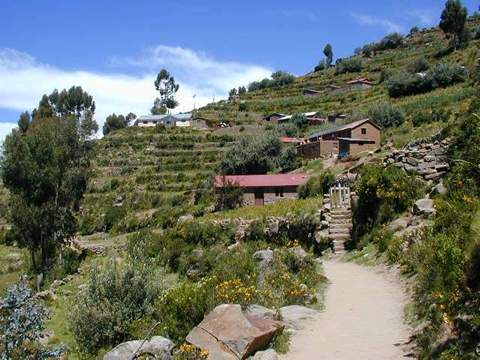 |
The Isla Taquile is a beautiful island set in the middle of Lake Titicaca. There are no vehicles of any kind on the island except for the boats that deliver goods. The path from the docks on one end of the island to the village climbs about 300 meters along a winding path. On the other end of the island, a steep rocky, nearly vertical staircase climbs to the village. The terraced hills are planted in quinoa, root vegetables, corn, and herbs with a generous sprinkling of flowers amid the stones.
|
|
The rich colors of the earth and the vegetation contrasted with the deep blue water of the lake are breath-takingly beautiful. It was a clear, crisp day with only a few wispy clouds dotting the bluest of skies. | |
|
The people who live on the island are largely self-sufficient, and until recently resisted tourism and other intrusions from the outside world. Now, they will provide lodging with a family, but they don't seem particularly happy to do it. | |
|
Here, as in Puno and Arequipa, the peasants chew the leaves of the coca plants, but have few other vices. They dress in the traditional clothing dating from the original Spanish conquest. The men wear white blousy shirts, cummerbunds, black toreador pants and hats whose colors and patterns reveal their marital status, while the women wear large, many-layered circle skirts and colorful blouses. The women and girls spin yarn from the alpaca, and the men and boys (never the women) knit the garments. Everyone helps to carry the goods up the 500 some odd steps from the boats to the village while we marvel at their lung capacity. |
The church is simple and the festivals are heavily laced with traditional Quechuan activities. |
|
The Yavari is the oldest steamship on Lake Titicaca, an iron ship that was built in England in 1862, and shipped in parts aboard two vessels to be hauled up the mountain by mule and reassembled on the lake. The project took 6 years. After a life of service to the navy, the ship is slowly being restored as the funding trickles in, and is now open to the public. The captain and crew are very willing to take folks like us on a private tour of the ship, its engine room, crew quarters, and the steering station. | |
 | |
|
Some anchor windlass, huh? | |
|
| |
|
The size of the wheel gives one a sense of the size of the ship. |
Someone has to polish this binacle almost every day.
|

